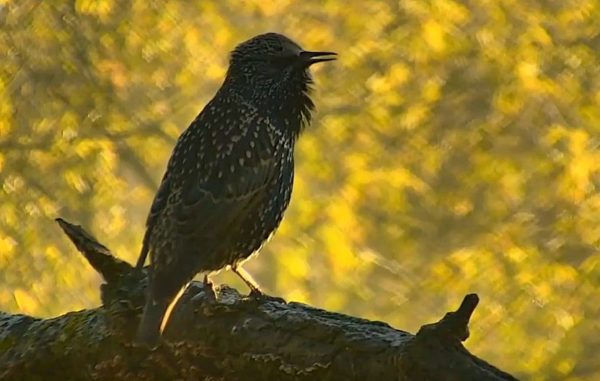Information About The Bird
[full]
[two_thirds class=”field_twothirds”]
Seen/Heard at
Decorah, Decorah North
Diet
European Starlings are ground feeders. Like crows, they eat almost anything, although they prefer insects and other invertebrates. Common prey includes grasshoppers, beetles, flies, caterpillars, snails, earthworms, millipedes, and spiders. They also eat fruits including wild and cultivated cherries, holly berries, hackberries, mulberries, tupelo, Virginia creeper, sumac, and blackberries, as well as grains, seeds, nectar, livestock feed, and garbage.
Nesting
European Starlings breed from mid-April through early June. Males establish a territory and begin singing to attract a mate. Starling nests are started by males, who choose a cavity and fill it with twigs, weeds, grass, leaves, trash, feathers, and string. Females often assist in or complete the later stages of nest construction, which includes making a nest cup within the larger structure. The cup is lined with feathers, fine bark shreds, and grass. Females lay four to six eggs pearl-white eggs per clutch and produce up to two broods per year. Both parents incubate eggs for about 12 days and young stay in the nest for roughly 21 days. To learn more, visit Cornell’s website.
Mozart had a pet European Starling that may have contributed to one of his musical pieces. You can learn more about that – and some surprising things about Mozart’s musical sense of humor – here: https://www.vqronline.org/essays-articles/2016/07/twinkle-twinkle-vogel-staar.
Citations
Bird Range Maps of North America
Ridgely, R.S., T.F. Allnutt, T. Brooks, D.K. McNicol, D.W. Mehlman, B.E. Young, and J.R. Zook. 2003.
Digital Distribution Maps of the Birds of the Western Hemisphere, version 1.0. NatureServe, Arlington, Virginia, USA. Data provided by NatureServe in collaboration with Robert Ridgely, James Zook, The Nature Conservancy – Migratory Bird Program, Conservation International – CABS, World Wildlife Fund – US, and Environment Canada – WILDSPACE.
Web Link: http://bit.ly/2ynPQ5I
The Cornell Lab of Ornithology Birds of North America: https://birdsna.org/Species-Account/bna/species/eursta/introduction
[/two_thirds]
[third class=”field_third”]
General Description
During the summer, European Starlings have glossy black body plumage with purple and greenish iridescence, especially on their heads, backs, and breasts. During the winter, they have dark to chocolate brown plumage with white to buff spots. Their beaks are yellow in the summer, dark in the winter, and very long. In flight, they may resemble small four-pointed stars – hence the name starling.
Migration
European Starlings can be found in the Decorah area year-round, although some wintering starlings could be short-distance migrants from colder northern areas.
Measurements
Length
7.9-9.1 in/20-23 cm
Wingspan
12.2-15.8 in/31-40 cm
Weight
2.1-3.4 oz/60-96 g
Wing Design
High Speed. Optimized for a high level of control at a sustained speed.
Videos
Singing Starling on North Eagles Cam
Starling Murmuration
[/third]
[/full]
| See also different: | Decorah Nest, Decorah North Nest, Starlings |
